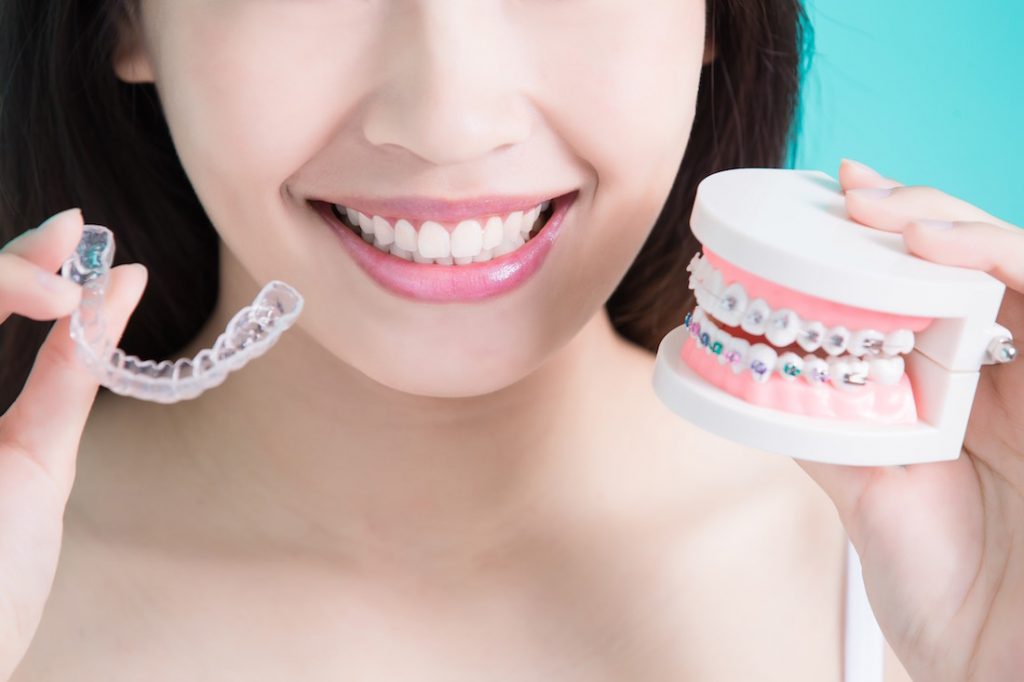In today’s society of selfies, social media, and Snapchat, adults and teens care more than ever about beautiful, straight teeth.
Historically, traditional braces were the only option to achieve straight teeth. In fact, traditional braces have been around for about 60 years.
But in recent years, Invisalign hit the market – offering a new, almost invisible option to dental patients.
How does one choose between the two? Both options are meant to straighten teeth as safely and as quickly as possible, but the similarities stop there.
Read on to learn more about Invisalign vs traditional braces, and the best option for you to achieve that desirable, pearly smile.
Dental Corrections Needed
Before making a decision based on appearance or comfort, ask your dentist whether Invisalign is even an option for you.
Some dental work, like canine tooth rotation or vertical movement, may not be achievable with Invisalign. If this is the case, Invisalign vs traditional braces will be an easy decision for you.
Looks
This is the #1 reason that Invisalign has become a popular option. No one likes a mouthful of metal! Invisalign trays are thin, clear trays that are removable if needed (for a hot date or a big presentation at work.) You can’t do that with those pesky wires on traditional braces!
For adults, this often means that Invisalign is the clear winner. Most adults aren’t proud to admit that their teeth need a little shifting, so the less obvious, the better.
But remember: just because Invisalign trays are clear, doesn’t mean they’re completely invisible. Some people can still see the trays, and often patients get small “clips” to hold the trays in place. The clips aren’t invisible, either, but you have to look close to see them.
Comfort
During the early weeks of wearing traditional braces, many dental patients get sores inside their mouths due to the metal wires. But with Invisalign, there are no uncomfortable wires poking into your lips or inner cheek.
That said, both Invisalign and traditional braces are uncomfortable when getting tooth adjustments. Any tooth movement will be uncomfortable.
For braces, this movement occurs when the dentist tightens the wires. For Invisalign, this is when you need to put in a new tray (which occurs every 2 weeks.) So if you’re considering Invisalign vs traditional braces and you’re looking to avoid any and all discomfort, you’re out of luck.
Kid, Teen, or Adult?
Discipline is a big factor, too. Invisalign trays must be worn every single day for 22 hours per day, and this can be tough for kids or teens. Also, kids and teens don’t often care that their parents are dishing out thousands for orthodontic work. For these younger dental patients, braces may be a better bet since there’s no option to remove them (and this makes parents very happy!)
Also, some kids and teens actually like the look of braces, because the colors are customizable! Plus, when all your friends have braces, it’s kind of the “cool” thing to do!
But for most adults who are paying for their own dental work (and seeking orthodontics because they want prettier teeth) discipline isn’t usually a problem. In this case, Invisalign is no problem because adults intend to keep the trays in their mouth for the hourly requirement each day.
Also worth noting: for kids or teens who play impact sports, traditional braces may do more harm than good. The metal wires can cause damage to the inside of a person’s mouth, so keep this in mind when choosing between Invisalign vs traditional braces.
Convenience
Another factor to consider in the Invisalign vs traditional braces debate: convenience.
With traditional braces, patients need to be seen regularly by a dentist in order to adjust wires, bands, etc. But with Invisalign, the dentist orders all trays upfront and sends them home with you. This means that there are no appointments to tighten wires.
That said, many dentists do like to check the fit of Invisalign trays every 4-6 weeks. So, you’re not totally out of the clear – but the check-ins are normally quick and painless.
Hygiene
Let’s face it: traditional braces are gross. Not so with Invisalign. You remove trays before eating, meaning that food won’t get caught in the trays.
But, with both Invisalign and traditional braces, you need to brush your teeth after eating. In the case of traditional braces, this ensures that food particles are dislodged from the wires.
In the case of Invisalign, this means that you aren’t replacing the trays with food stuck in your teeth. Not brushing your teeth can mean that food particles and bacteria may start to cause tooth decay. Yuck!
Weight Loss?!
This one might seem out of left field, but as we just said, you have to remove Invisalign trays before eating, and then brush your teeth before replacing the trays.
For many people, this means that snacking is just too much work! Many Invisalign patients report weight loss during their treatment. And, in fact, some brides-to-be view Invisalign treatment as the perfect time to do a pre-wedding weight loss routine, while also getting beautiful, straight teeth!
Cost
Here’s where traditional braces finally come out ahead: they aren’t as expensive as Invisalign.
For some, the cost difference between the two isn’t material; it really depends on what type of movement your teeth need. Ask your orthodontist for a quote on both options, which can help you make the decision.
Invisalign vs Traditional Braces: Making the Final Decision
When achieving straight teeth, your two primary options are Invisalign vs traditional braces. Appearance, comfort, cost, and other factors come into play.
We understand it can be a confusing, stressful decision. Let us help you! Contact us today to talk about your own orthodontic needs. You’ll be on your way to a beautiful smile in no time!




